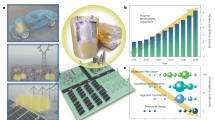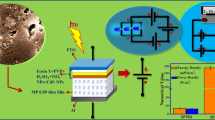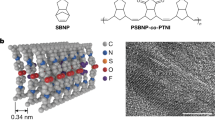Abstract
Safety issues have been a long-standing obstacle impeding large-scale adoption of next-generation high-energy-density batteries. Materials solutions to battery safety management are limited by slow response and small operating voltage windows. Here we report a fast and reversible thermoresponsive polymer switching material that can be incorporated inside batteries to prevent thermal runaway. This material consists of electrochemically stable graphene-coated spiky nickel nanoparticles mixed in a polymer matrix with a high thermal expansion coefficient. The as-fabricated polymer composite films show high electrical conductivity of up to 50 S cm−1 at room temperature. Importantly, the conductivity decreases within one second by seven to eight orders of magnitude on reaching the transition temperature and spontaneously recovers at room temperature. Batteries with this self-regulating material built in the electrode can rapidly shut down under abnormal conditions such as overheating and shorting, and are able to resume their normal function without performance compromise or detrimental thermal runaway. Our approach offers 103–104 times higher sensitivity to temperature changes than previous switching devices.
This is a preview of subscription content, access via your institution
Access options
Subscribe to this journal
Receive 12 digital issues and online access to articles
$119.00 per year
only $9.92 per issue
Buy this article
- Purchase on Springer Link
- Instant access to full article PDF
Prices may be subject to local taxes which are calculated during checkout





Similar content being viewed by others
Change history
19 March 2024
A Correction to this paper has been published: https://doi.org/10.1038/s41560-024-01508-8
References
Dunn, B., Kamath, H. & Tarascon, J.-M. Electrical energy storage for the grid: a battery of choices. Science 334, 928–935 (2011).
Choi, N. S. et al. Challenges facing lithium batteries and electrical double-layer capacitors. Angew. Chem. Int. Ed. 51, 9994–10024 (2012).
Goodenough, J. B. & Park, K. S. The Li-ion rechargeable battery: a perspective. J. Am. Chem. Soc. 135, 1167–1176 (2013).
Lu, L., Han, X., Li, J., Hua, J. & Ouyang, M. A review on the key issues for lithium-ion battery management in electric vehicles. J. Power Sources 226, 272–288 (2013).
Wang, Q. et al. Thermal runaway caused fire and explosion of lithium ion battery. J. Power Sources 208, 210–224 (2012).
Finegan, D. P. et al. In-operando high-speed tomography of lithium-ion batteries during thermal runaway. Nature Commun. 6, 6924 (2015).
Feng, X. M., Ai, X. P. & Yang, H. X. A positive-temperature-coefficient electrode with thermal cut-off mechanism for use in rechargeable lithium batteries. Electrochem. Commun. 6, 1021–1024 (2004).
Balakrishnan, P. G., Ramesh, R. & Prem Kumar, T. Safety mechanisms in lithium-ion batteries. J. Power Sources 155, 401–414 (2006).
Zhang, S. S. A review on the separators of liquid electrolyte Li-ion batteries. J. Power Sources 164, 351–364 (2007).
Baginska, M. et al. Autonomic shutdown of lithium-ion batteries using thermoresponsive microspheres. Adv. Energy Mater. 2, 583–590 (2012).
Choi, J.-A., Kim, S. H. & Kim, D.-W. Enhancement of thermal stability and cycling performance in lithium-ion cells through the use of ceramic-coated separators. J. Power Sources 195, 6192–6196 (2010).
Jung, Y. S. et al. Improved functionality of lithium-ion batteries enabled by atomic layer deposition on the porous microstructure of polymer separators and coating electrodes. Adv. Energy Mater. 2, 1022–1027 (2012).
Feng, J. K., Ai, X. P., Cao, Y. L. & Yang, H. X. Polytriphenylamine used as an electroactive separator material for overcharge protection of rechargeable lithium battery. J. Power Sources 161, 545–549 (2006).
Li, S. L., Ai, X. P., Yang, H. X. & Cao, Y. L. A polytriphenylamine-modified separator with reversible overcharge protection for 3.6 V-class lithium-ion battery. J. Power Sources 189, 771–774 (2009).
Zhang, H., Cao, Y., Yang, H., Lu, S. & Ai, X. A redox-active polythiophene-modified separator for safety control of lithium-ion batteries. J. Polym. Sci. B 51, 1487–1493 (2013).
Hyung, Y. E., Vissers, D. R. & Amine, K. Flame-retardant additives for lithium-ion batteries. J. Power Sources 119–121, 383–387 (2003).
Xiang, H. F., Xu, H. Y., Wang, Z. Z. & Chen, C. H. Dimethyl methylphosphonate (DMMP) as an efficient flame retardant additive for the lithium-ion battery electrolytes. J. Power Sources 173, 562–564 (2007).
Buhrmester, C. et al. Studies of aromatic redox shuttle additives for LiFePO4-based Li-ion cells. J. Electrochem. Soc. 152, A2390–A2399 (2005).
Chen, Z., Qin, Y. & Amine, K. Redox shuttles for safer lithium-ion batteries. Electrochim. Acta 54, 5605–5613 (2009).
Zhang, L., Zhang, Z., Wu, H. & Amine, K. Novel redox shuttle additive for high-voltage cathode materials. Energy Environ. Sci. 4, 2858–2862 (2011).
Zhang, L., Zhang, Z., Redfern, P. C., Curtiss, L. A. & Amine, K. Molecular engineering towards safer lithium-ion batteries: a highly stable and compatible redox shuttle for overcharge protection. Energy Environ. Sci. 5, 8204–8207 (2012).
Chen, R.-J., Wu, F., Li, L., Qiu, X.-P. & Chen, S. Binary molten salt electrolytes based on LiClO4 and 2-oxazolidinone. Acta Phys.-Chim. Sin. 23, 554–558 (2007).
Xu, K., Zhang, S., Allen, J. L. & Jow, T. R. Nonflammable electrolytes for Li-ion batteries based on a fluorinated phosphate. J. Electrochem. Soc. 149, A1079–A1082 (2002).
Wong, D. H. C. et al. Nonflammable perfluoropolyether-based electrolytes for lithium batteries. Proc. Natl Acad. Sci. USA 111, 3327–3331 (2014).
Zhang, X.-W., Wang, C., Appleby, A. J. & Little, F. E. Characteristics of lithium-ion-conducting composite polymer-glass secondary cell electrolytes. J. Power Sources 112, 209–215 (2002).
Ghosh, A., Wang, C. & Kofinas, P. Block copolymer solid battery electrolyte with high Li-ion transference number. J. Electrochem. Soc. 157, A846–A849 (2010).
Liu, G., Reinhout, M., Mainguy, B. & Baker, G. L. Synthesis, structure, and ionic conductivity of self-assembled amphiphilic poly(methacrylate) comb polymers. Macromolecules 39, 4726–4734 (2006).
Liu, G., Reeder, C. L., Sun, X. & Kerr, J. B. Diffusion coefficients in trimethyleneoxide containing comb branch polymer electrolytes. Solid State Ion. 175, 781–783 (2004).
Bouchet, R. et al. Single-ion BAB triblock copolymers as highly efficient electrolytes for lithium-metal batteries. Nature Mater. 12, 452–457 (2013).
Li, J. et al. A positive-temperature-coefficient layer based on Ni-mixed poly(vinylidene fluoride) composites for LiFePO4 electrode. Int. J. Electrochem. Sci. 8, 5223–5231 (2013).
Zhou, F., Zhao, X. & Dahn, J. R. Impact of Al or Mg substitution on the thermal Stability of Li1.05Mn1.95−zMzO4 (M = Al or Mg). J. Electrochem. Soc. 157, A798–A801 (2010).
Xia, L., Li, S.-L., Ai, X.-P., Yang, H.-X. & Cao, Y.-L. Temperature-sensitive cathode materials for safer lithium-ion batteries. Energy Environ. Sci. 4, 2845–2848 (2011).
Bloor, D., Graham, A., Williams, E. J., Laughlin, P. J. & Lussey, D. Metal–polymer composite with nanostructured filler particles and amplified physical properties. Appl. Phys. Lett. 88, 102103 (2006).
Bartenev, G. M., Remizova, A. A., Kuleshov, I. V. & Martynov, M. A. Volume expansion of polyethylene with various degrees of crystallinity over a wide range of temperatures. Polym. Sci. USSR 15, 2808–2813 (1973).
Yang, G. F., Song, K. Y. & Joo, S. K. A metal foam as a current collector for high power and high capacity lithium iron phosphate batteries. J. Mater. Chem. A 2, 19648–19652 (2014).
Veith, G. M. & Dudney, N. J. Current collectors for rechargeable Li-air batteries. J. Electrochem. Soc. 158, A658–A663 (2011).
Nan, C. W., Shen, Y. & Ma, J. Physical properties of composites near percolation. Annu. Rev. Mater. Res. 40, 131–151 (2010).
Alvarez, M. P., Poblete, V. H., Pilleux, M. E. & Fuenzalida, V. M. Submicron copper-low-density polyethylene conducting composite-structural electrical and percolation threshold. J. Appl. Polym. Sci. 99, 3005–3008 (2006).
Xia, L., Zhu, L., Zhang, H. & Ai, X. A positive-temperature-coefficient electrode with thermal protection mechanism for rechargeable lithium batteries. Chin. Sci. Bull. 57, 4205–4209 (2012).
Chen, R. et al. Positive temperature coefficient effect of polymer-carbon filler composites under self-heating evaluated quantitatively in terms of potential barrier height and width associated with tunnel current. Polymer 53, 5197–5207 (2012).
Wei, D., Zhao, T. & Xiao, S. Y. Resistivity-volume expansion characteristics of carbon black-loaded polyethylene. J. Appl. Polym. Sci. 77, 53–58 (2000).
Kono, A. et al. Positive-temperature-coefficient effect of electrical resistivity below melting point of poly(vinylidene fluoride) (PVDF) in Ni particle-dispersed PVDF composites. Polymer 53, 1760–1764 (2012).
Li, D., Yang, K., Chen, S. & Wu, F. Thermal behavior of overcharged nickel/metal hydride batteries. J. Power Sources 184, 622–626 (2008).
Kise, M. et al. Development of new safe electrode for lithium rechargeable battery. J. Power Sources 146, 775–778 (2005).
Zhong, H., Kong, C., Zhan, H., Zhan, C. & Zhou, Y. Safe positive temperature coefficient composite cathode for lithium ion battery. J. Power Sources 216, 273–280 (2012).
Yoon, S.-M. et al. Synthesis of multilayer graphene balls by carbon segregation from nickel nanoparticles. ACS Nano 6, 6803–6811 (2012).
Acknowledgements
This work was partially supported by the Department of Energy, Laboratory Directed Research and Development funding, under contract DE-AC02-76-SF00515 and by the Precourt Institute for Energy at Stanford University. We thank K. Yan for discussions and J. Tok for proof reading of the manuscript.
Author information
Authors and Affiliations
Contributions
Z.B., Y.C. and Z.C. conceived and designed the experiment. Z.C. carried out materials fabrication, characterization and testing. P.-C.H. conducted COMSOL simulations. J.L. performed DSC measurements. Y.L. conducted the graphene coating for nano-spiky nickel particles. J.W.F.T. and N.L. did the XPS and Raman characterization, respectively. C.W., S.C.A. and J.L. provided constructive advice for the experiment and figure preparation. Z.C. wrote the first draft. Z.B. and Y.C. revised the manuscript. All authors made comments on the paper.
Corresponding authors
Ethics declarations
Competing interests
The authors declare no competing financial interests.
Supplementary information
Supplementary Information
Supplementary Figures 1–16, Supplementary Table 1 and Supplementary References. (PDF 1548 kb)
Supplementary Video 1
Demonstration of the fast thermal switching behavior of TRPS devices made by PE/GrNi. (MOV 7458 kb)
Supplementary Video 2
Demonstration of slicing properties of TRPS film. (MOV 25386 kb)
Rights and permissions
About this article
Cite this article
Chen, Z., Hsu, PC., Lopez, J. et al. Fast and reversible thermoresponsive polymer switching materials for safer batteries. Nat Energy 1, 15009 (2016). https://doi.org/10.1038/nenergy.2015.9
Received:
Accepted:
Published:
DOI: https://doi.org/10.1038/nenergy.2015.9
This article is cited by
-
A three-terminal magnetic thermal transistor
Nature Communications (2023)
-
Wearable and flexible electrochemical sensors for sweat analysis: a review
Microsystems & Nanoengineering (2023)
-
Self-shutdown function and uniform Li-ion flux enabled by a double-layered polymer electrolyte for high-performance Li metal batteries
Journal of Solid State Electrochemistry (2023)
-
Stimulus-responsive polymers for safe batteries and smart electronics
Science China Materials (2022)
-
High safety separators for rechargeable lithium batteries
Science China Chemistry (2021)



